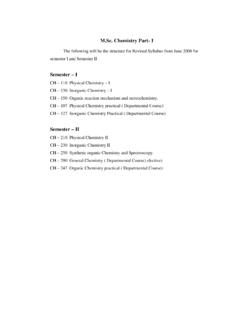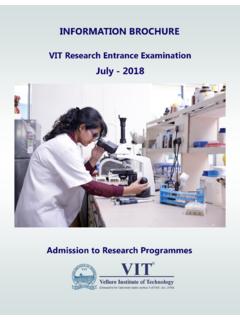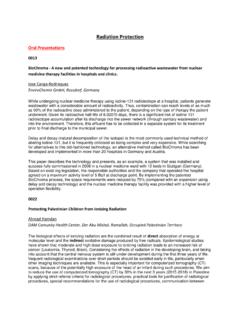Transcription of Total Body Irradiation (TBI) - uthgsbsmedphys.org
1 Total body Irradiation (TBI)by Adam MelanconApril 9, 2015by Adam MelanconApril 9, 2015 Special Procedures at MDACC (June 2014) GK Total body Total Skin IORT GK Total body Total Skin IORT442 459 457 479 ?37 43 49 7439 to date17 13 26 2520 to date30 26 58 12 ?442 459 457 479 ?37 43 49 7439 to date17 13 26 2520 to date30 26 58 12 ?FY10 FY11 FY12 FY13 FY14 FY10 FY11 FY12 FY13 FY14 Total body Irradiation (TBI) Clinical Basis For TBI AAPM Report 17 (Task Group 25) Recommendations Current MD Anderson technique Clinical Basis For TBI AAPM Report 17 (Task Group 25) Recommendations Current MD Anderson TechniquePrimary Purposes of TBI Immunosuppression : For BMT (To kill lymphocyte cells to allow engraftment of donor stem cells) Cytoreduction: Eradication of malignant cells (Leukemias, Lymphomas, etc) Eradication of cell populations with genetic disorders (Fanconi s anemia) Immunosuppression : For BMT (To kill lymphocyte cells to allow engraftment of donor stem cells) Cytoreduction.
2 Eradication of malignant cells (Leukemias, Lymphomas, etc) Eradication of cell populations with genetic disorders (Fanconi s anemia)Uses of Total body IrradiationHigh Dose TBI To destroy host s bone marrow and kill residual cancer cells To immunosuppress pt prior to Bone Marrow Transplant (BMT) Usually adjuvant Chemotherapy +/- TBI prior to BMT transplantHigh Dose TBI To destroy host s bone marrow and kill residual cancer cells To immunosuppress pt prior to Bone Marrow Transplant (BMT) Usually adjuvant Chemotherapy +/- TBI prior to BMT transplantUses of Total body IrradiationHigh Dose TBITx regimen: 4 10 Gy Single fraction (LD50 ~ 4 Gy) 6 Gy 3 Gy x 2, BID 10 14 GyFractionated12 Gy in Gy x 8 fx BID or 2~3 Gy daily fx14 Gy in Gy x 8 fx BID 12 Gy in Gy x 6 fx BID (Europe)Dose Rate :Between 5 and 25 cGy/minHigh Dose TBITx regimen: 4 10 Gy Single fraction (LD50 ~ 4 Gy) 6 Gy 3 Gy x 2, BID 10 14 GyFractionated12 Gy in Gy x 8 fx BID or 2~3 Gy daily fx14 Gy in Gy x 8 fx BID 12 Gy in Gy x 6 fx BID (Europe)Dose Rate :Between 5 and 25 cGy/minUses of Total body IrradiationHigh Dose TBI : Unlike most other treatment delivered by a radiation oncologist, high-dose TBI is potentially lethal without intensive medical support and stem cell backup.
3 Incorrectly delivered TBI may result in fatal toxicity as Dose TBI : Unlike most other treatment delivered by a radiation oncologist, high-dose TBI is potentially lethal without intensive medical support and stem cell backup. Incorrectly delivered TBI may result in fatal toxicity as Complications - SequelaeHigh Dose TBILung Toxicity is most concernedEarly Side effects: Nausea, Vomiting, Diarrrhea Within 10 days - Dry mouth, sore throat, reduced tear formationHepatic enlargement, gonad failure, poor renal functionSingle fraction ~ 26% pt pop: interstitial pneumonitis may be avoided using fractionationCataract formation (85% / 11 years)Risk of re-development of second tumor (chemo- Irradiation + BMT) ~ 20% High Dose TBILung Toxicity is most concernedEarly Side effects: Nausea, Vomiting, Diarrrhea Within 10 days - Dry mouth, sore throat, reduced tear formationHepatic enlargement, gonad failure, poor renal functionSingle fraction ~ 26% pt pop.
4 Interstitial pneumonitis may be avoided using fractionationCataract formation (85% / 11 years)Risk of re-development of second tumor (chemo- Irradiation + BMT) ~ 20% Uses of Total body IrradiationLow Dose TBIWhy :To reduce risk and serious complicationsFor : Lymphocytic Leukemia, Lymphomas, and NeuroblastomaDose : 10 15 cGy/day for 10 15 days2 Gy single fractionLow Dose TBIWhy :To reduce risk and serious complicationsFor : Lymphocytic Leukemia, Lymphomas, and NeuroblastomaDose : 10 15 cGy/day for 10 15 days2 Gy single fractionLow Dose TBI Recently, a single fraction low-dose TBI (2 Gy) combined with various chemotherapy regimens has emerged as an effective form of immuno-suppression prior to allogenic stem cell transplantation in non-myeloablative approaches. Some trials reported only minor acute treatment-related toxicities and faster hematopoietic engraftment.
5 Recently, a single fraction low-dose TBI (2 Gy) combined with various chemotherapy regimens has emerged as an effective form of immuno-suppression prior to allogenic stem cell transplantation in non-myeloablative approaches. Some trials reported only minor acute treatment-related toxicities and faster hematopoietic cases from Jan-June 2014 37 pts received TBI, including 18 pedi and 19 adults Adults Prescription Gy x 1 (18 cases) Gy x 4 (1 case) Pedi Prescription: Gy x 8 BID (5 cases) Gy x 8 BID (1 case) Gy x 8 BID (5 cases) 3 Gy x 2, 2Gy x 2, 4Gy x 2 2Gy x 1, 3Gy x 1, Gy x 1 Dependent on transplant protocols and patient conditions (lung, kidney, heart functions) 37 pts received TBI, including 18 pedi and 19 adults Adults Prescription Gy x 1 (18 cases) Gy x 4 (1 case) Pedi Prescription: Gy x 8 BID (5 cases) Gy x 8 BID (1 case) Gy x 8 BID (5 cases) 3 Gy x 2, 2Gy x 2, 4Gy x 2 2Gy x 1, 3Gy x 1, Gy x 1 Dependent on transplant protocols and patient conditions (lung, kidney, heart functions)State of the Art 1938 Heublin ~1932, USALead lined ward, 4 beds at one end, Coolidge tube at other endBeds 5 and 7m from tubeTx all 4 pts at one time!
6 20 Hrs, 185 Kvp, 3mA, 2mm ~ R/Hr as a % of erythema dose.(Bird cage!)State of the Art? 2000 Shielded treatment room 4 - 18 MV beams Bed 4 to 5m from targetOne patient a timeCustom blocks/bolus/MUUniform Dose ( 10%?)State of the Art? 2000 Typical Rx Note: BID with 6 hrs apart Setup Note:1. SAD 380 cm2. Lucite scatter plate3. Rice bags at neck4. Dose rate 300 mu/min5. Lung blocks 4,6,8 fx6. Dose calc to midplane level of umbilicus Purpose of AAPM Report #17 Review methods for producing large fields for TBI, HBI, and other large field procedures Make recommendations regarding dosimetric measurements required for large fields Consider the practical problems of specifying and delivering radiation doses for such large fields Cost vs Benefit Small enough room to minimize cost + Shielding + space Simple procedure fewer sources Review methods for producing large fields for TBI, HBI, and other large field procedures Make recommendations regarding dosimetric measurements required for large fields Consider the practical problems of specifying and delivering radiation doses for such large fields Cost vs Benefit Small enough room to minimize cost + Shielding + space Simple procedure fewer sourcesTBI MethodsAAPM Report 17.
7 Figure sourcestwo horizontal beamssingle source, short SSDtwo vertical beamshead rotationhalf body , adjacentdirect fieldsTBI MethodsAAPM Report 17, figure source,long SSDsource moves horizontallypatient moves horizontallyhalf body , directand oblique fieldsParallel-opposed Lateral FieldsDose HomogeneityAAPM Report 17, figure Dose HomogeneityAAPM Report 17, figure 2. The ratio of peak dose to midline dose decreases: As patient thickness decreases With increasing beam energy With increasing SSD This implies better techniques use High energy, long SSD, and AP-PA beamorientations. If High Energies are used, consideration must be given to effects of low doses in BU (buildup) region. Dose in BU may be increased by adding a beam spoiler (plastic plate) near pt skin. The ratio of peak dose to midline dose decreases: As patient thickness decreases With increasing beam energy With increasing SSD This implies better techniques use High energy, long SSD, and AP-PA beamorientations.
8 If High Energies are used, consideration must be given to effects of low doses in BU (buildup) region. Dose in BU may be increased by adding a beam spoiler (plastic plate) near pt skin. TBI Dose Distributions AAPM Report 17, Figure 9, 60Co parallel opposed beams 10% dose uniformity is possible for AP-PA beam orientation only AAPM Report 17, Figure 9, 60Co parallel opposed beams 10% dose uniformity is possible for AP-PA beam orientation onlyExt Contour Correction Pt water equivalentBolusTBI Dose Distributions AAPM Report 17, Figure 10, 25 MV parallel opposed beams 10% uniformity is possible for both lateral and AP-PA beam orientations AAPM Report 17, Figure 10, 25 MV parallel opposed beams 10% uniformity is possible for both lateral and AP-PA beam orientationsBoosting Skin DoseSummary Choice of Energy & SSD Preferred Higher energy Longer SSD AP/PA beam orientation Scatter plate close to the patient Preferred Higher energy Longer SSD AP/PA beam orientation Scatter plate close to the patientBasic Phantom Dosimetry Water is the material of choice Plastic phantom need corrections to convert to water dose Minimum size, 30x30x30 cm3 Larger size preferred, use additional buildup material Need to correct for lack of full scatter Depends on phantom size, field size and energy Dosimeter should be energy independent Stem and cable effects should be minimized Water is the material of choice Plastic phantom need corrections to convert to water dose Minimum size, 30x30x30 cm3 Larger size preferred.
9 Use additional buildup material Need to correct for lack of full scatter Depends on phantom size, field size and energy Dosimeter should be energy independent Stem and cable effects should be minimizedLateral Fields CompensatorsMDACC technique (s)Classic TechniqueChair TechniquePediatric TechniqueMDACC TBI AP/PA Classic technique 380 cm SAD40 40 cmcollimator 45 , Gantry 90 scatter plateMidline LaserUmbilicus380 cm SADU mbilicusVarian 2108 18 MVAP viewPA viewMDACC TBI SetupMDACC TBI SetupMDACC TBI Lung blocks Lungs fully shielded for 4, 6, 8 fractions Block shadows are aligned on patient in treatment position Port film (40 MU) taken Blocks adjusted (if necessary) and port film retaken (if necessary) MU for port film(s) subtracted from treatment MU Lungs fully shielded for 4, 6, 8 fractions Block shadows are aligned on patient in treatment position Port film (40 MU) taken Blocks adjusted (if necessary) and port film retaken (if necessary) MU for port film(s) subtracted from treatment MUMDACC TBI Lung BlocksMDACC TBI Lung BlocksIn-Vivo TLD MeasurementsMDACC TBI Setup Notes Lateral decubitus position, patient lying on styrofoam (lifts patient off gurney) Scatter plate close to patient Rice bags for neck bolus Laser on calves for AP, on ankle for PA Legs bent to fit patient in light field Lateral decubitus position, patient lying on styrofoam (lifts patient off gurney)
10 Scatter plate close to patient Rice bags for neck bolus Laser on calves for AP, on ankle for PA Legs bent to fit patient in light fieldTBI dose uniformity(TLD, RANDO phantom, Therac 20, no bolus)RANDO slice #85%90%95%100%105%110%115%05101520253035 midlineposterior skin surfaceanterior skin surfaceNeckPelvisChair TechniqueSCOT-TBI Chair technique , AP/PA Beam Energy 6 MV Dose = 4 x 200 cGy/Fraction Dose to Lung & Kidney = 50 cGy/Fraction Dose Uniformity(Points 1-5): 10% of 200cGy/fraction Chair technique , AP/PA Beam Energy 6 MV Dose = 4 x 200 cGy/Fraction Dose to Lung & Kidney = 50 cGy/Fraction Dose Uniformity(Points 1-5): 10% of 200cGy/fraction Lung and Kidney SCOT blocksSCOT blocksShielding(shaded area)LungKidneyIf CT alone (no U-sound) cm4 cmDose PointsDose Prescribed: Umbilicus (mid plane) Dose Prescribed: Umbilicus (mid plane) # 1 Head# 6 Hip# 2 Neck# 7 Rt Knee# 3Rt Shoulder# 8 Rt Ankle# 4 Mid Mediastinum # 9 Rt Lung# 5 Lumbar Spine#10 Rt KidneyUTMDACC Division of Radiation OncologyRadiation Physics DepartmentK.





